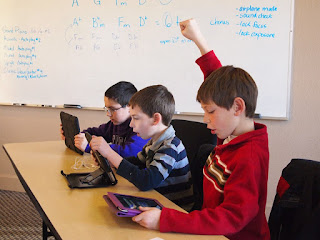Mobile Technologies Are Now An Integral
Part Of Education
General Word:
I remember six years ago when my
then 4-year-old child began using my mobile phone. I was amazed at how
comfortable she was chatting to daddy on a phone while shopping at the grocery
store. She thought nothing of using this object that had no plugs or wires to
hear her father’s voice. Today this same child has a younger sister who not
only takes mobile phones for granted, but assumes anything can be a mobile
phone. I remember when my youngest was 2- years-old. She would pick up any
random object and just begin talking into it.
Description of Mobile Technologies Are Now An Integral Part Of Education :
For my children in suburban
Maryland, mobile technologies are now an integral part of their everyday living
and play experiences. But this is not the case for all children. Many live in
places where mobile technologies are just becoming affordable. Others live in
areas where there is no cell phone service at all. And still other children
live in places where basic living necessities outweigh the need for electronic
technologies. There are extreme differences in children’s opportunities and
challenges for learning with new technologies. This book is about mobile
technologies for all of these children.
This book is not about how to
make mobile technologies. It is about how to make BETTER mobile technologies
for the world’s children. This book is about how to understand the impact that
these technologies can have, and apply those lessons to making new learning
experiences for children that are more effective, engaging, and expressive.
This book will ask you to consider a diverse landscape of research and products
to inspire and challenge your thinking. This would have been a much easier book
to write if the authors could give you a step-by-step guide on what to build
and how to use it, but that just isn’t possible.
The world is too large, diverse, and messy,
and the pace of innovation is just too fast. There are so many technological
solutions to consider, so many contexts to explore for scenarios of use, and so
many different goals that could support learning. Together this suggests the need
for a rich and complex book. This is the book you now read. It contains the
work of 43 authors from 9 countries. These authors have diverse points of view,
in part due to the disciplines they represent. They are computer scientists,
HCI professionals, social scientists, educational researchers, non-profit or
NGO leaders, academic and industry researchers and practitioners.
They are people making change in
their organizations. They work in developing countries and industrialized
nations, in war-torn areas and established centers of commerce and peace. They
consider the use of mobile technologies in classrooms, homes, outdoors, and
public spaces. And the “mobile
technology” that they consider spans a wide variety of platforms—including mobile phones, GPS systems,
laptops, game controllers, mp3 players, book readers, and even pen-based
computing. This diversity in
perspective, experience, and technology is critical in understanding future new
directions.
Developing a mobile theory of
learning:
Existing applications for
mobile-learning tend to employ design and evaluation principles taken from
traditional or e-learning theories, which results in mere “mobile
versions” of established tools. This
design approach fails to take into full account the distinct aspects of
learning through mobile technologies. The potential for mobile technologies to
contribute to lifelong, dynamic, contextualized, and social learning rests on
the establishment of principles that highlight and exploit the specific
characteristics of learning with mobile technologies.
Numerous researchers have called
for a learning theory specific to mobile technologies that will allow for
effective assessment, instructional strategies, and design of mobile
applications (Klopfer and Squire, 2003; Zurita and Nussbaum, 2004; Naismith,
Londsale, Vavoula, and Sharples, 2004). A theory of mobile learning should
encourage an authentic, collaborative experience in addition to allowing
teachers the opportunity to be more efficient and responsive to the needs of
learners of various backgrounds and capabilities (Rodríguez, Nussbaum, Zurita,
Rosas, and Lagos, 2001; Attewell, 2005b; Scanlon, Jones and Waycott, 2005;
Cobcroft, Towers, Smith, and Bruns, 2006).
It should also ensure that mobile
applications taken “off the shelf” and those specifically designed for
educational purposes can be evaluated using similar standards. Some researchers
have advocated for a conversational approach to creating a mobile learning
theory, suggesting that mobile technologies encourage learning that is social,
autonomous, and continuous. Others have added that a framework must incorporate
socioconstructivist and lifelong learning theories while taking into account
learner mobility, the ubiquity of mobile technologies, and informal learning
environments (Sharples, 2005; Sharples, Taylor, and Vavoula, 2005).
The skill sets, design
principles, and practice exemplars outlined in this book can also provide
insights into how we might further develop theoretical approaches to support
the next generation of mobile learning. It is a critical matter; only once
educators and designers understand how we might effectively use these mobile
devices to support learning can they be used to their full potential.
You Also Like: The Impact Of E-Books On Library Services












No comments:
Post a Comment